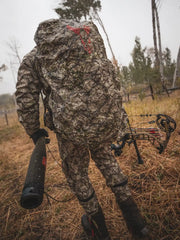Definition: Meat Sweats [meet sw-ettes] adjective
1) As first defined by Joey Tribbiani, the meat sweats are the body’s natural reaction to consuming mass quantities of animal protein in one sitting.
2) What hunters experience by choosing an inferior pack to haul out harvested game.
Meat sweats can be a funny phenomenon. In one case, they are the result of too much success (either at the Thanksgiving table or the Mongolian grill). In our world, however, we want to help you avoid the protein perspiration as much as possible. Here’s how it’s done.
Size Matters
First, you need to make an honest evaluation of your space needs. It’s really easy to fall into the cubic-inch rabbit hole and get the biggest pack you can find. But, if you’re not hunting game of similar size, you’re just setting yourself up for pain. Pack capacity is like any other bit of space, be it a “big” living room or your laptop’s hard drive. If there’s empty space… we’re gonna fill it.
And like the living room or the hard drive, we’ll fill the pack with unnecessary items. Why? Because we can, damn it!
So be realistic, and then pick a pack that is large enough for your needs, but doesn’t tempt you to add 32TB of Roadrunner cartoons or random giant letters from TJ Maxx.
Fortunately, we offer a (figurative) ton of options in sizes, ranging from the meat-capable Vario 22 day pack to the muy grande Carbon Ox or Vario 65 OS packs. The right size for you is out there.
Weight a Minute
Second is kind of a corollary of no. 1. You’re planning on adding 100 or more pounds of critter to your back, so it only makes sense to start out as light as possible. Here’s where the capacity question comes back up, as well as construction. Do I need an external frame? How does the pack situate the load on my back? Are there additional attachment points so I can set up my pack as needed?
Just be cautious and find the right balance. Lightweight is great, until it can’t handle the load. Heavy gets the job done, but you pay the price. Somewhere in the middle, next to the little blonde girl eating porridge, is juuuuuuuuuuust right.
While there’s an obvious connection between size and weight, you might be shocked at how narrow that margin might be.
For example, a mere 23oz separates the 2,400ci MRK2 pack from the big ol’ 6,100ci MRK6 in our brand new MRK pack series. Then when you drop the 3,300ci MRK3 into the mix, at 6.5lb, you’ve got a whole lot of meat-packing power in a super tough, durable frame pack.
Throwing a Fit
Last, but far from least, is the fit. Is the pack ergonomically correct for your body? If not, is it adjustable where it needs to be? If your body type is outside the realm of average, you need a pack that adjusts to your longer torso, or a waistbelt that adapts to your well-insulated midsection. You need a pack that will adapt to you, because trust us, your spine isn’t going to willingly relocate itself.
We like our spines just the way they are: Heavily abused from a lifetime of outdoor fun, unrelated to carrying a backpack. So we’ve built a crazy amount of adjustability into each and every pack. Want to know how to get your pack dialed in? Catch Blake showing you how it’s done here.
Once you find a pack (or packs) that meet this checklist, then you can start looking at some of the optional features that may make things a bit easier. Like what, you ask?
We’ve already touched on external connection points, but we’ll repeat how great they are for either loading up a pack for the hike in, or stripping it down for the heavy haul out.
A dedicated meat shelf is also a great addition. These are designed to put the most weight in the most ergonomically appropriate place possible. Loads can then be cinched down. Plus, they’re a heck of a lot easier to clean than the internal pocket on your pack.
Repeat after us: Load. Lifters.
These little straps may seem like nothing much, but drawing them up appropriately tight when you have a load on can turn your mile-long hike from a miserable march to a pleasant walk in the woods. These magnificent inventions draw the load up close to your back, and transfer the weight from your shoulders down to the frame or body and into the waistbelt, which is where the magic happens with heavy packs.
At the end of the day, strapping half an elk to your back for the hike out is a workout all on its own. There’s no need to make that any more difficult than it already is. Be smart, pick your pack wisely, and take (some of) the pain out of the haul out.
















